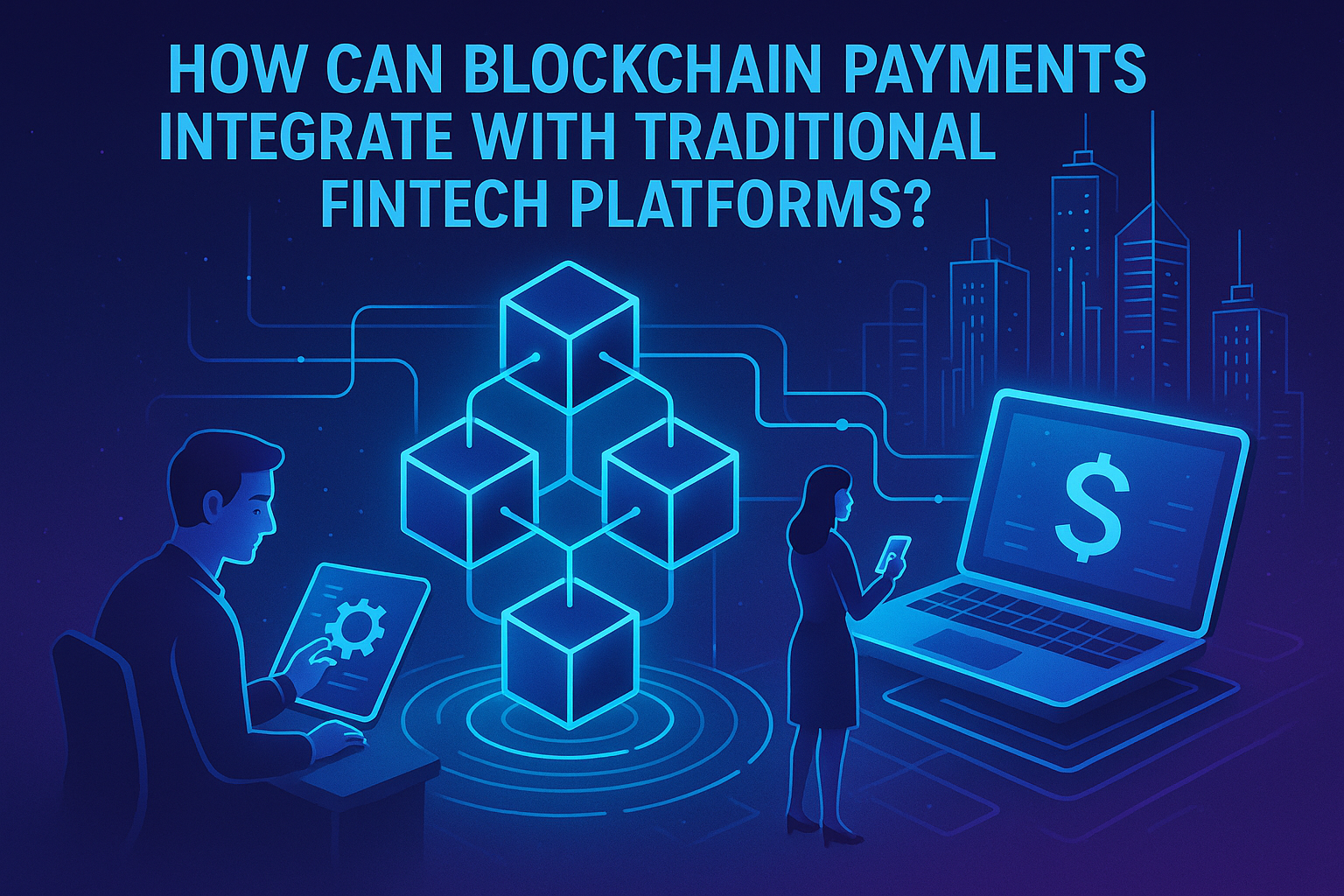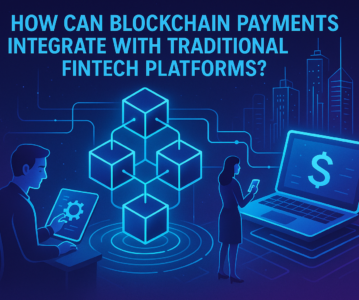Introduction
In recent years, the financial technology (fintech) landscape has witnessed tremendous growth and transformation, reshaping how individuals and businesses conduct financial transactions. Two of the most significant innovations in this realm are blockchain payments and traditional fintech platforms. Blockchain payments, built on decentralized ledger technology, promise speed, transparency, and security. Traditional fintech platforms, on the other hand, have revolutionized digital banking, lending, payments, and wealth management by leveraging modern software architectures and robust regulatory frameworks.
The integration of blockchain payments with traditional fintech platforms is not just a technological trend—it is a strategic imperative for the future of finance. This convergence promises to deliver enhanced efficiency, greater financial inclusion, and new business opportunities. As industry stakeholders increasingly explore synergies between these two domains, understanding the integration pathways, challenges, and value creation potential becomes crucial. This article provides an in-depth, structured analysis of how blockchain payments can be integrated with traditional fintech platforms, supported by current data, real-world examples, and insights into future trends.

Current State of Blockchain Payments
Blockchain payment systems have evolved significantly since the introduction of Bitcoin in 2009. Initially conceived as an alternative to fiat currency, blockchain has grown into a versatile infrastructure supporting various digital assets, stablecoins, and even central bank digital currencies (CBDCs). According to a 2023 report by Statista, the global blockchain market in banking and financial services reached 5.9billionandisprojectedtosurpass5.9 billion and is projected to surpass 22.5 billion by 2026, underscoring the sector’s rapid adoption and growth.
Real-world applications span across remittances, cross-border payment settlements, merchant payments, and supply chain finance. Companies like Ripple (with its XRP-based payment protocol) and Stellar have facilitated billions of dollars in cross-border transactions, significantly reducing settlement times from days to mere seconds. In 2022, Santander Bank processed over $600 million in cross-border payments using RippleNet, demonstrating mainstream adoption. Similarly, Visa and Mastercard have launched pilot programs to settle transactions using USDC and other stablecoins, signaling growing acceptance among incumbents.
The principal advantages of blockchain payments include near-instant settlement, lower transaction costs, enhanced transparency, and reduced reliance on intermediaries. For example, traditional SWIFT-based international transfers can cost 25–25–50 and take 2–5 days to settle, whereas blockchain-based transactions often cost less than $1 and settle within minutes. These benefits have driven adoption by remittance providers (e.g., MoneyGram’s partnership with Stellar), e-commerce platforms, and even governments piloting CBDCs in countries like China, Nigeria, and the Bahamas.
Traditional Fintech Platforms
Traditional fintech platforms encompass a broad array of digital solutions transforming financial services. These platforms typically offer online banking, digital wallets, peer-to-peer (P2P) lending, robo-advisory services, and digital payment gateways. According to EY’s 2023 Global Fintech Adoption Index, 64% of consumers worldwide have used at least one fintech platform, indicating broad market penetration.
The core functions of traditional fintech platforms include account management, payments, fund transfers, lending, and investment management. For instance, PayPal, with over 430 million active accounts as of Q4 2023, enables consumers and merchants to send and receive funds globally. Similarly, Square (now Block Inc.) processes billions in merchant payments annually, leveraging seamless user interfaces and robust security protocols. These platforms rely on established infrastructure—such as card networks, ACH systems, and regulatory compliance engines—to facilitate safe, regulated transactions.
Notably, traditional fintech platforms have become critical pillars of modern finance, supporting both consumers and small businesses. For example, Ant Group’s Alipay in China processes over $17 trillion in annual transactions, demonstrating the scale and efficiency achieved through digital transformation. These platforms have also driven financial inclusion, with companies like M-Pesa in Kenya enabling millions of unbanked users to access digital financial services.
Integration Models and Paths
Technical Integration Models
Integrating blockchain payments with traditional fintech platforms can be achieved through several technical models. The most common approach involves Application Programming Interfaces (APIs) that allow fintech platforms to access blockchain networks or stablecoin rails. For example, Visa’s Crypto APIs enable partner banks and fintechs to offer crypto payments, settlements, and custodial services directly within their apps. Similarly, Fireblocks and Circle provide APIs for fintechs to integrate USDC payments, custody, and on/off-ramping between fiat and crypto assets.
Another emerging model is the hybrid ledger approach, where both blockchain and traditional databases coexist. This allows fintech platforms to maintain legacy compliance, auditing, and reporting features while utilizing blockchain for settlement and reconciliation. J.P. Morgan’s JPM Coin is a notable case, enabling internal transfers on a permissioned blockchain while interfacing with existing payment systems.
Operational and Regulatory Integration
Operationally, the integration often involves partnerships between blockchain firms and traditional financial institutions. For example, MoneyGram’s collaboration with Stellar enables users to receive remittances in digital dollars, which are then instantly converted to local fiat currency at participating retail locations. This “last mile” integration solves real-world challenges such as cash-out and regulatory compliance.
Regulatory integration is equally important, given the stringent requirements governing financial services. Leading fintechs have adopted compliance-as-a-service solutions, leveraging blockchain’s transparency for anti-money laundering (AML) and Know Your Customer (KYC) checks. For instance, Chainalysis and Elliptic provide analytics tools that fintechs use to monitor blockchain transactions for suspicious activity, ensuring adherence to global regulations.
Case Studies
A prime example of integration is the partnership between Coinbase and PayPal. Coinbase users can now withdraw cryptocurrency directly to PayPal accounts, bridging the gap between digital assets and fiat-based payment platforms. Similarly, Mastercard’s Crypto Card program allows users to spend cryptocurrencies at over 90 million merchants globally, with real-time conversion to local currencies. These initiatives demonstrate how technical, operational, and regulatory integration can be accomplished at scale.
Challenges and Barriers
Technical Challenges
Despite the promise of integration, several technical challenges persist. Interoperability between blockchain networks and traditional payment rails remains a key obstacle. Many blockchain systems operate in silos, lacking standardized protocols for seamless data exchange. For example, while stablecoins like USDC and USDT are widely used, their integration with legacy banking systems often requires complex middleware solutions and reconciliation processes.
Scalability is another technical concern. Public blockchains, such as Ethereum, have faced congestion and high transaction fees during periods of peak demand. This was evident during the 2021 DeFi boom, where Ethereum gas fees exceeded $50 per transaction at times. Such volatility undermines user experience and limits mainstream adoption by fintechs that require predictable costs and throughput.
Regulatory and Security Barriers
Regulatory uncertainty is perhaps the most significant barrier to integration. Jurisdictions vary widely in their treatment of digital assets, with some (e.g., the European Union’s MiCA framework) providing clear guidelines, while others (e.g., the United States) maintain fragmented and evolving rules. This creates compliance risks for fintechs seeking to offer blockchain-based payments, particularly regarding AML, KYC, and consumer protection.
Security is a further concern. While blockchain offers strong cryptographic guarantees, vulnerabilities in smart contracts, custodial wallets, and integration layers have led to high-profile breaches. According to Chainalysis, crypto-related thefts exceeded $3.8 billion in 2022, underscoring the need for robust security standards and audits. Traditional fintech platforms must invest in multi-layered security, including secure key management and real-time monitoring, to mitigate these risks.
User Adoption and Experience
User adoption is influenced by factors such as trust, ease of use, and education. Many consumers remain skeptical of cryptocurrencies due to volatility and negative media coverage. User interfaces for blockchain payments are often less intuitive compared to mature fintech apps, creating friction for mainstream users. Bridging this gap requires investment in user experience design, transparent communication, and customer support.
Opportunities and Value Creation
Enhanced Efficiency and Cost Savings
The integration of blockchain payments with traditional fintech platforms offers significant efficiency gains and cost savings. By leveraging near-instant settlement and reduced reliance on intermediaries, fintechs can lower transaction costs and pass these savings to consumers. McKinsey estimates that cross-border payments could save up to $4 billion annually in fees through blockchain adoption. For small businesses and freelancers, this means faster access to working capital and reduced friction in global commerce.
New Business Models and Revenue Streams
Integration also enables new business models and revenue streams. Decentralized finance (DeFi) protocols, when integrated with fintech platforms, can offer yield products, tokenized assets, and programmable payments. For example, fintechs can embed blockchain-based lending or savings accounts, allowing users to earn interest on digital assets directly within their banking app. Companies like Revolut and N26 have already begun experimenting with crypto trading and staking features, attracting younger, tech-savvy customers.
Financial Inclusion and Global Reach
Blockchain integration can drive greater financial inclusion, especially in regions with limited banking infrastructure. By enabling low-cost, cross-border transactions and programmable remittances, fintechs can serve unbanked and underbanked populations more effectively. The World Bank estimates that global remittance flows reached $647 billion in 2022, with fees averaging 6.3%. Blockchain-powered platforms like BitPesa (now AZA Finance) have reduced remittance fees in Africa to under 3%, demonstrating real-world impact.
Case Examples
A compelling case is Mastercard’s partnership with Paxos to enable banks to offer crypto trading in the US. This collaboration has streamlined access to digital assets for millions of bank customers, creating a regulated, user-friendly bridge between traditional finance and blockchain. Another example is the Central Bank of Nigeria’s eNaira, which integrates with local fintech apps to facilitate digital payments, government disbursements, and microloans, driving adoption at scale.
Conclusion & Future Trends
The integration of blockchain payments with traditional fintech platforms represents a transformative opportunity for the financial services industry. As discussed, blockchain payments bring transparency, speed, and efficiency, while traditional fintech platforms offer scale, regulatory compliance, and trusted customer relationships. Together, they can redefine the way money moves around the world—making transactions faster, cheaper, and more accessible.
Looking ahead, several trends are likely to shape the future of this integration. Firstly, interoperability protocols such as ISO 20022, Polkadot, and Cosmos will mature, enabling seamless data exchange between blockchains and legacy systems. Secondly, regulatory clarity will improve as jurisdictions adopt comprehensive frameworks for digital assets, reducing compliance uncertainty for fintechs. Initiatives like the European Union’s Markets in Crypto-Assets Regulation (MiCA) and the US’s proposed stablecoin legislation are paving the way.
Thirdly, the emergence of central bank digital currencies (CBDCs) will accelerate integration, as governments and private fintechs collaborate to build hybrid payment ecosystems. China’s Digital Yuan and the European Central Bank’s digital euro pilot are prime examples of this trend. Finally, advances in user experience design, education, and security will reduce barriers to adoption, making blockchain payments as intuitive and trusted as traditional banking services.
In summary, while challenges remain, the integration of blockchain payments and traditional fintech platforms is both inevitable and desirable. It will unlock new efficiencies, business models, and opportunities for financial inclusion, benefiting both incumbents and new entrants. Fintech professionals and enthusiasts should closely monitor this evolution, invest in the necessary technology and partnerships, and proactively engage with regulators to shape the financial infrastructure of tomorrow. The future of finance will be collaborative, interoperable, and decentralized—offering unprecedented value to users worldwide.
